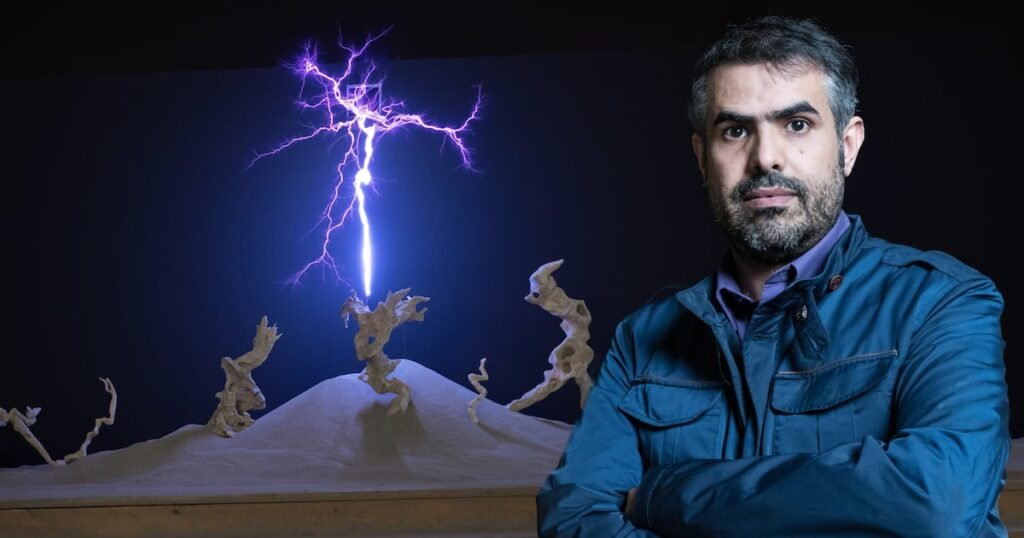The first art teacher of the influential Saudi artist Ahmed Mater was his mother.
Hailing from Aseer, a province in south-west Saudi Arabia, she was an Al-Qatt Al-Asiri artist – a style of Arabic art drawn on the walls of the front parlour of traditional Arab homes, recognisable for their intricate geometric designs in bright colours.
“This was the first language of art that told me that art is symbolic, that art is telling a story, that art is your voice,” Mater tells The National. “Here, art is from society, it’s part of the family. Art was not inside a frame. It’s art for life. It’s coming out of the frame to be part of the walls, part of our lifestyle.”
After three decades, Mater has himself arrived at a coveted space in his career as an artist.
In a global first, Christie’s auction house is holding a mid-career retrospective of Mater’s work taking place at their headquarters in London from July 17 to August 22.
Entitled Ahmed Mater: Chronicles, the comprehensive exhibition will feature more than 100 works across painting, drawing, photography, sculpture, video and installation. The exhibition will include one of Mater’s earliest works, My Village, painted when he was only 16, as well as a mural work by his mother.

The exhibition is a unique opportunity for the public to experience Mater’s explorations of a transformative time across Saudi Arabia’s social and cultural make up and identity. It’s a transformation that also speaks of the region and in many ways universal concepts and concerns.
“Ahmed Mater is an artist who’s not afraid of dealing with very sensitive topics,” says curator Dr Ridha Moumni, who’s also the chairman of Christie’s Middle East & Africa.
“He’s also not afraid of working with new media, he’s not afraid of dealing with different projects. For me, the most interesting part of Ahmed Mater is his brain and capacity to think of a thing and mature ideas that he translates into artworks.”
Mater has documented across mediums and styles the evolving nature of the region through various interconnected themes such as religion, social economy, political influence, capitalism and consumerism.
“Art is one of the only things that allow us to look back and to see the future or to make us expect or think about the future. It’s really philosophy,” he says.
“Art connects us to story, to time, to feeling. Art is poetic also. It carries this poem from the past until today.”
The idea of art as poetry, of making the viewer feel before they understand, is an undercurrent across Mater’s work, and an intention he aims for.

“This is very important – art is not inclusive anymore, art is part of society,” he says. “I want people to feel my artwork. For me, this poetic element is the last or at least the most difficult part of the artwork, when you get the poetic feeling.”
One of Mater’s most seminal works, a work with that powerful poetic presence, is the large-scale photograph Lightning Land (2017). In the photo, lighting strikes a dark desert landscape, while a traditional tent is silhouetted against the blaze and a factory is illuminated on the horizon.
Mater was on a trip to Dammam when he started to photograph the landscape during a storm. It was just before the rain fell and a dust cloud was gathering. As lighting struck, Mater was prepared, capturing the moment with a long exposure in his camera.

“When I saw the picture, I felt satisfied,” he says. “I know I created this story of a futurism.”
The image is powerful. Not only for its contrast of light and dark, its stark composition and otherworldly atmosphere, but for everything it represents. It is an allegorical vision of Saudi Arabia, and the Gulf, the impulsive force of the image is a reminder of how society in the region has changed.
“This work for me is very important because it’s the junction between old and new,” he says. “It’s the in-between two places. It’s the intersection. This artwork is for me a story of Saudi futurism, or if I can say widely across the region.”
Lightning Land is a rare work of great vision and thought but also of one that was created through impulse and instinct. Like all his work, it’s not only a portrait of a time and place but also a peek into how Mater creates work and brings his ideas to life no matter the medium.
“What I want is for people to take the opportunity of having all these works together at Christie’s to discover who is Ahmed Mater,” Moumni says.
“But on the other hand, I want them to be much more familiar also of the environment, and the frame of the life of Ahmed Mater, which means the lens in which he’s living in Saudi Arabia. So what I really want is for them to learn, because Ahmed Mater is an artist you will learn a lot from.”
Ahmed Mater’s retrospective at Christie’s, London, runs from July 17 to August 22
Updated: June 29, 2024, 3:03 AM






